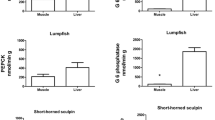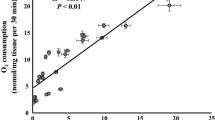Summary
The rates of lactate and glucose production, removal, and oxidation were measured in harbor seals before and after 10 min restrained dives using radioisotope tracer techniques. The results show:
-
1.
Net turnover rates were 24 μmol·min−1·kg−1 for lactate and 12 μmol·min−1·kg−1 for glucose at rest (Table 2).
-
2.
Only 21% of lactate turnover and 3% of glucose turnover were oxidized. Their combined oxidation contributed less than 9% to resting energy production.
-
3.
During 10 min dives, there was 9 fold increase in lactate production.
-
4.
Less than 27% of the lactate produced during diving was oxidized during recovery.
-
5.
The blood glucose concentration decreased 1 mM during diving, but increased and remained elevated for 2 h after the dive (Fig. 5 and 6). The postdive hyperglycemia resulted from a high glucose entry rate which lasted 10–15 min after the dive. A peak entry rate of 168 μmol·min−1·kg−1 was measured 30 sec after a dive.
-
6.
In spite of the postdive hyperglycemia, glucose oxidation was only 11% higher than predive levels.
-
7.
The predive concentration of plasma free fatty acids (FFA) was similar to other arctic carnivores (Fig. 9).
Similar content being viewed by others
References
Altszuler N, Barkai A, Bjerknes C, Gottlieb B, Steele R (1975) Glucose turnover values in the dog obtained with various species of labeled glucose. Am J Physiol 229:1662–1667
Basso LV, Havel RJ (1970) Hepatic metabolism of free fatty acids in normal and diabetic dogs. J Clin Invest 49:537–547
Blazquez E, Castro M, Herrera E (1971) Effect of a high-fat diet on pancreatic insulin release, glucose tolerance and hepatic gluconeogenesis in male rats. Rev Espan Fisiol 27:297–304
Broden V, Hajek M, Andel M (1979) Analysis of rapid oscillations of glucose and free fatty acids in plasma. Eur J Appl Physiol 41:159–171
Cahill GF Jr, Ashmore J, Renold AE, Hastings AB (1959) Blood glucose and the liver. Am J Med 26:264–282
Castellini MA, Somero G, Kooyman GL (1981) Glycolytic enzyme activities in tissues of marine and terrestrial mammals. Physiol Zool 54:242–252
DeFreitas ASW, Depocas F (1970) Glyceride-glucose release and the interconversion of glucose and glycerol in normal and fasted rats. Can J Physiol Pharmacol 48:561–568
Depocas F, DeFreitas ASW (1970) Methode for estimating rates of formation and interconversion of glucose-glycerol and glucose-lactic acid in intact animals. Can J Physiol Pharmacol 48:557–560
Depocas F, Hart JS (1957) Use of the Pauling oxygen analyzer for measurement of oxygen consumption of animals in open-circuit systems and in a short-lag, closed-circuit apparatus. J Appl Physiol 10:388–392
Depocas F, Hart JS, Fisher HD (1971) Sea water drinking and water flux in starved and fed harbor seals (Phoca vitulina). Can J Physiol Pharmacol 49:53–62
Dole VP (1956) A relation between non-esterified fatty acids in plasma and the metabolism of glucose. J Clin Invest 35:150
Dunn A, Chenoweth M, Schaeffer LD (1967) Estimation of glucose turnover and the Cori Cycle using glucose-6t-14C*. Biochemistry 6:5–11
Dunn A, Chenoweth M, Bever K (1977) Use of3H and14C doubly labeled glucose and amino acids in the study of hormonal regulation of gluconeogenesis in rats. Fed Proc 36:245–252
Dunn A, Katz J, Golden S, Chenoweth M (1976) Estimation of glucose turnover and recycling in rabbits using various (3H,14C)glucose labels. Am J Physiol 230:1159–1162
Eisenstein AB, Strack I (1971) Effect of high protein feeding on gluconeogenesis in rat liver. Diabetes 20:577–585
Eisenstein AB, Strack I, Steiner A (1974) Increased hepatic gluconeogenesis without a rise of glucagon secretion in rats fed a high fat diet. Diabetes 23:869–875
Eldridge FL, T'so L, Chang H (1974) Relationship between turnover rate and blood concentration of lactate in normal dogs. J Appl Physiol 47:316–620
Ferguson JH, Folk GE Jr (1971) Free fatty acid levels in several species of arctic carnivores. Comp Biochem Physiol [B] 40:309–312
Freminet A, Poyart C (1975) Lactate-glucose interrelations, glucose recycling and the Cori Cycle in normal fed rats. Pflügers Arch 361:25–31
Freminet A, Bursaux E, Poyart CF (1974) Effect of elevated lactatemia on the rates of lactate turnover and oxidation in rats. Pflügers Arch 346:75–86
George JC, Vallyathan NV, Ronald K (1971) The harp sealPagophilus groenlandicus (Erxleben, 1777). VII. A histophysiological study of certain skeletal muscles. Can J Zool 49:25–30
Goodman LS, Gilman A (1975) The pharmacological basis of therapeutics. Macmillan, New York, pp 477–491
Hance AJ, Robin ED, Halter JB, Lewiston N, Robin DA, Cornell L, Caligiuri M, Theodore J (1982) Hormonal changes and enforced diving in the harbor sealPhoca vitulina. II. Plasma catecholamines. Am J Physiol 242:R528-R532
Hart JS, Irving L (1959) The energetics of harbor seals in air and in water with special consideration of seasonal changes. Can J Zool 37:447–457
Hochachka PW, Owen TG, Allen JF, Whittow GC (1975) Multiple end products of anaerobiosis in diving vertebrates. Comp Biochem Physiol [B] 50:17–22
Hochachka PW (1976) Design of metabolic and enzymic machinery to fit lifestyle and environment. Biochem Soc Symp 41:3–31
Hochachka PW (1981) Brain, lung, and heart functions during diving and recovery. Science 212:509–514
Hochachka PW, Murphy B, Liggins GC, Zapol W, Creasy R, Snider M, Schneider R, Quist J (1979) Unusual maternalfetal blood glucose concentrations in Weddell seal. Nature 277:388–389
Issekutz B Jr, Shaw WAS, Issekutz AC (1976) Lactate metabolism in resting and exercising dogs. J Appl Physiol 40:312–319
Issekutz TB, Issekutz B Jr, Elahi D (1974) Estimation of hepatic glucose output in non-steady state. The simultaneous use of 2-3H-glucose and14C-glucose in the dog. Can J Physiol Pharmacol 52:215–224
Jones DR, Fisher HD, McTaggart S, West NH (1973) Heart rate during breath-holding and diving in the unrestrained harbor seal (Phoca vitulina richardi). Can J Zool 51:671–680
Jones GB (1965) Determination of specific activity of labeled blood glucose by liquid scintillation using glucose pentaacetate. Anal Biochem 12:249–258
Judson GJ, Leng RA (1972) Estimation of the total entry rate and resynthesis of glucose in sheep using glucose uniformly labeled with14C and variously labeled with3H. Aust J Biol Sci 25:1312–32
Keith E, Pernia S, Condit R, Ortiz CL (1979) Metabolism and recycling of glucose in northern elephant seal. 3rd Biennial Conf Biol Mar Mamm, pp 33 (Abstr)
Kerem D, Elsner R (1973) Cerebral tolerance to asphyxial hypoxia in the harbor seal. Respir Physiol 19:188–200
Kettelhut IC, Foss MC, Migliorini RH (1980) Glucose homeostasis in a carnivorous animal (cat) and in rats fed a high-protein diet. Am J Physiol 239:R437-R444
Kooyman GL, Campbell WB (1972) Heart rates in freely diving Weddell seals,Leptonychotes weddelli. Comp Biochem Physiol [A] 43:31–36
Kooyman GL, Kerem DH, Campbell WB, Wright JJ (1973) Pulmonary gas exchange in freely diving Weddell seals,Leptonychotes weddelli. Respir Physiol 17:283–290
Kooyman GL, Wahrenbrock EA, Castellini MA, Davis RW, Sinnett EE (1980) Aerobic and anaerobic metabolism during voluntary diving in Weddell seals: evidence of preferred pathways from blood chemistry and behavior. J Comp Physiol 138:335–346
Kreisberg RA, Pennington LF, Boshell BR (1970) Lactate turnover and gluconeogenesis in normal and obese humans: effect of starvation. Diabetes 19:53–63
Kreisberg RA (1972) Glucose-lactate inter-relations in man. N Engl J Med 287:132–137
Kronfeld DS (1977) Glucose transport and recycling determined by means of two tracers and multicompartmental analysis. Fed Proc 36:259–264
Masoro EJ, Rowell LB, McDonald RM, Steiert B (1966) Skeletal muscle lipids. ii. Nonutilization of intracellular lipid esters as an energy source for contractile activity. J Biol Chem 241:2626–2634
Murphy B, Zapol WM, Hochachka PW (1980) Metabolic activities of heart, lung and brain during diving and recovery in the Weddell seal. J Appl Physiol 48:596–605
Nelson GJ (1970) The lipid composition of the blood of marine mammals-I. Young elephant seal,Mirounga angustirostris, and Harp seals,Papophilus groenlandicus. Comp Biochem Physiol 34:109–116
Porte D Jr, Robertson RP (1973) Control of insulin secretion by catecholamines, stress, and the sympathetic nervous system. Fed Proc 32:1792–1796
Radziuk J, Norwich KH, Vranic M (1978) Experimental validation of measurements of glucose turnover in non-steady state. Am J Physiol 234:E84-E93
Randle PJ, Garland PB, Hales CN, Newsholme EA (1963) The glucose fatty-acid cycle: its role in insulin sensitivity and the metabolic disturbances of diabetes mellitus. Lancet I:785–789
Reilly PEB (1975) Use of reverse isotope dilution analysis to determine blood plasma (L(+)-14C-lactate specific radioactivity. Anal Biochem 64:37–44
Ridgway SH (1972) Mammals of the sea. Thomas, Springfield, Illinois, pp 664–675
Rhoades RA, Shaw ME, Eskew ML, Wali S (1978) Lactate metabolism in perfused rat lung. Am J Physiol 235:E619-E623
Roberts S, Samuels LT, Reinecke RM (1943) Previous diet and the apparent utilization of fat in the absence of the liver. Am J Physiol 140:639–644
Robin ED, Ensinck J, Hance AJ, Newman A, Lewiston N, Cornell L, Davis RW, Theodore J (1981) Glucoregulation and simulated diving in the harbor seal. Am J Physiol 241:R292-R300
Schmidt-Nielsen K (1970) Energy metabolism, body size, and problems of scaling. Fed Proc 29:1524–1532
Scholander PF (1940) Experimental investigations on the respiratory function in diving mammals and birds. Hval Skrift 22:1–31
Scholander PF (1947) Analyzer for accurate estimation of respiratory gases in 1/2 cc samples. J Biol Chem 167:235–250
Scholander PF, Irving L, Grinnel SW (1942) Aerobic and anaerobic changes in seal muscles during diving. J Biol Chem 142:431–440
Searle GL, Cavalieri RR, DeGrazia J, Zarcone V, Porte D Jr, Bagdade JD (1974) Kinetics of lactate turnover and oxidation in man. Proc Int Atomic Energy Agency Conf (SM185) 47:473–481
Sinnett EE, Kooyman GL, Wahrenbrock EA (1978) Pulmonary circulation of the harbor seal. J Appl Physiol 45:718–727
Steele R (1959) Influences of glucose loading and of injected insulin on hepatic glucose output. Ann NY Acad Sci 82:420–430
Steele R, Wall JS, De Bodo RC, Altzuler N (1956) Carbohydrate metabolism of hypophysectomized dogs as studied with radioactive glucose. Am J Physiol 187:25–31
Steele R, Wall JS, De Bodo RC, Altszuler N (1959) Measurement of size and turnover rate of body glucose pool by the isotope dilution method. Am J Physiol 187:15–24
Steele R, Winkler B, Rathgeb I, Bjerknes C, Altszuler N (1968) Plasma glucose and free fatty acid metabolism in normal and long-fasted dogs. Am J Physiol 214:313–319
Stetten MR, Stetten D Jr (1955) Glycogen regeneration in vivo. J Biol Chem 1213:723–732
Suzuki H, Fuwa H (1970) Influence of dietary composition on the capacity of glucose formation in the liver of rats. Agric Biol Chem 34:80–87
Trout DL, Estes EH Jr, Friedberg SJ (1960) Titration of free fatty acids of plasma: a study of current methods and a new modification. J Lipid Res 1:199–202
Weiland D, Mondon CE, Reaven GM (1980) Evidence for multiple causality in the development of diabetic hypertriglyceridemia. Diabetologia 18:335–340
Wolfe RR (1982) Stable isotope approaches for the study of energy substrate metabolism. Fed Proc 41:2692–2697
Wolfe RR, Burke JF (1977) Effect of burn trauma on glucose turnover, oxidation, and recycling in guinea pigs. Am J Physiol 233:E80-E85
Wolfe RR, Miller HI, Spitzer JJ (1977) Glucose and lactate kinetics in burn shock. Am J Physiol 232:E415-E418
Author information
Authors and Affiliations
Rights and permissions
About this article
Cite this article
Davis, R.W. Lactate and glucose metabolism in the resting and diving harbor seal (Phoca vitulina). J Comp Physiol B 153, 275–288 (1983). https://doi.org/10.1007/BF00689631
Accepted:
Issue Date:
DOI: https://doi.org/10.1007/BF00689631




